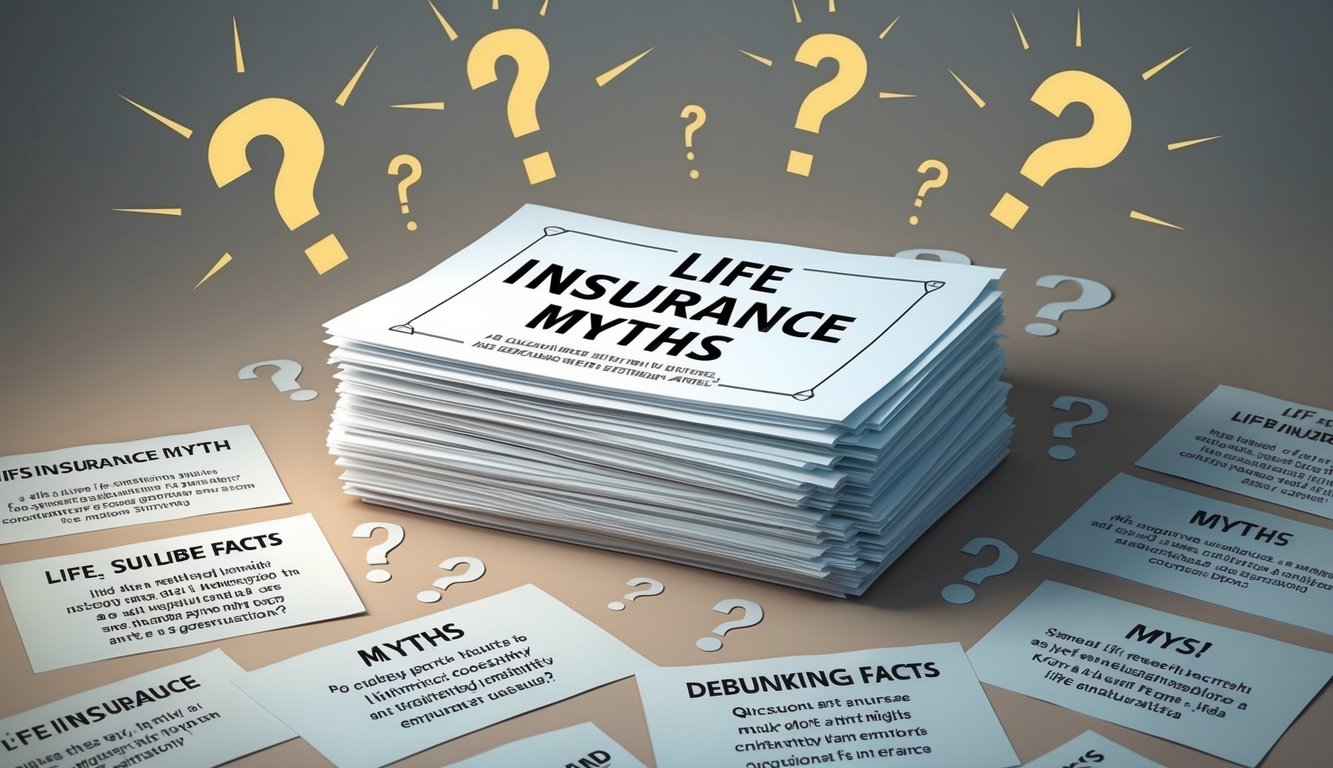Life insurance can be a crucial financial tool for protecting your loved ones, yet many misconceptions surround this important coverage.
These myths often lead people to delay or avoid getting the protection they need.
Understanding the truth about life insurance is essential for making informed decisions about your financial future.
Debunking common life insurance myths can help you better evaluate your coverage needs and options. By separating fact from fiction, you can gain clarity on how life insurance works and its potential benefits for you and your family.
Let’s explore five prevalent misconceptions about life insurance and uncover the reality behind each one.
1) ‘Life insurance is too expensive’

Many people believe life insurance comes with a hefty price tag.
This common misconception often prevents individuals from exploring their coverage options.
In reality, life insurance can be quite affordable.
According to an Insurance Barometer Study, Americans overestimate the cost of term life insurance by three times.
The cost of life insurance varies based on several factors, including your age, health, and the type of policy you choose.
Term life insurance, for example, is typically less expensive than permanent life insurance.
You might be surprised to learn that life insurance policies can average around $40 to $55 per month.
This is often less than what you might spend on other monthly expenses like dining out or streaming services.
It’s important to note that the cost of life insurance tends to increase as you age.
This means that purchasing a policy earlier in life can often result in lower premiums.
When considering the cost of life insurance, think about the financial protection it provides for your loved ones.
The peace of mind knowing your family is financially secure can be invaluable.
Don’t let the misconception of high costs deter you from exploring your options.
Speak with an insurance professional to get accurate quotes based on your specific situation and needs.
2) ‘Only the primary breadwinner needs life insurance’
This myth overlooks the significant financial value of non-income-earning family members.
While the primary breadwinner’s income is crucial, it’s not the only factor to consider when determining life insurance needs.
Stay-at-home parents or partners contribute substantially to the household through unpaid labor.
If they were to pass away, the surviving spouse might need to pay for childcare, housekeeping, and other services previously handled by the deceased.
High-net-worth households often assume life insurance is only necessary for the primary income earner.
However, the death of any family member can create a significant financial gap.
Even if you’re not the primary earner, your contributions to the family are valuable.
Your life insurance can help cover funeral expenses, outstanding debts, and provide financial support to your loved ones.
The purpose of life insurance is to cover financial obligations so others aren’t required to do so.
This applies to all family members, not just the highest earner.
Consider the long-term financial impact of losing any family member.
Life insurance can provide a safety net, ensuring your family’s financial stability regardless of who passes away.
3) ‘Life insurance is only for older people’
This myth couldn’t be further from the truth.
Life insurance is valuable for people of all ages, not just seniors.
In fact, younger individuals often benefit from lower premiums when purchasing life insurance.
Getting life insurance early can be a smart financial move.
As you age, the cost of premiums typically increases.
By securing a policy when you’re young and healthy, you can lock in lower rates for the duration of your coverage.
Life insurance isn’t just about planning for your own passing.
It’s also about protecting your loved ones financially.
If you have dependents or debts, life insurance can provide crucial support regardless of your age.
Young adults with student loans or mortgages should consider life insurance.
It can help ensure these debts don’t burden your family if something unexpected happens to you.
Even if you’re single without dependents, life insurance can still be beneficial.
It can cover funeral expenses and any outstanding debts, preventing these costs from falling to your family.
Some life insurance policies offer living benefits.
These can provide financial support if you face a critical illness or disability, regardless of your age.
Remember, life is unpredictable.
Having life insurance gives you peace of mind, knowing your loved ones will be financially protected no matter when the unexpected occurs.
4) ‘Employer-provided life insurance is sufficient’
Many people believe that the life insurance provided by their employer is enough to protect their loved ones.
This assumption can be a costly mistake.
Employer-provided life insurance typically offers limited coverage.
It’s often only one to two times your annual salary, which may not be sufficient to meet your family’s long-term financial needs.
Your employer’s policy may not be portable.
If you change jobs or lose your employment, you might lose your coverage, leaving your family vulnerable.
The coverage provided by your employer might not account for your specific circumstances.
Your financial obligations, dependents, and future plans require a personalized approach to life insurance.
You have no control over the terms of an employer-provided policy.
The coverage amount, beneficiary options, and policy features are typically predetermined and may not align with your preferences.
Relying solely on employer-provided insurance can leave gaps in your financial protection.
It’s wise to consider supplementing this coverage with an individual policy tailored to your needs.
By obtaining your own life insurance, you gain more control over your coverage.
You can choose the policy type, coverage amount, and additional riders that best suit your family’s needs.
5) ‘Term life insurance is a waste of money if you outlive the term’
This myth stems from a misunderstanding of the purpose of term life insurance. Term life coverage is not a waste if you outlive the policy.
Term life insurance provides financial protection for your loved ones during a specific period when you need it most.
It’s designed to replace your income if you pass away unexpectedly.
Think of it like car insurance or health insurance.
You pay premiums for protection, hoping you won’t need to use it.
The peace of mind knowing your family is protected is valuable in itself.
If you outlive your term policy, it means you’re still alive and able to provide for your family.
This is a positive outcome, not a waste of money.
Term life insurance is typically more affordable than permanent life insurance.
The lower cost allows you to allocate more of your budget to other financial goals, such as saving for retirement or paying off debt.
When your term policy expires, you have options.
You can convert to a permanent policy, renew for another term, or decide you no longer need coverage if your financial situation has improved.
Understanding Life Insurance Policies

Life insurance policies come in various types, each designed to meet different needs and financial goals.
Selecting the right policy requires careful consideration of your unique circumstances and long-term objectives.
Types of Life Insurance Policies
Term life insurance provides coverage for a specific period, usually 10-30 years.
It offers affordable protection for your family during crucial years, like when raising children or paying off a mortgage.
Whole life insurance covers you for your entire lifetime.
It includes a savings component, building cash value over time that you can borrow against or withdraw.
Universal life insurance offers flexibility in premium payments and death benefits.
You can adjust these as your needs change, making it adaptable to various life stages.
Variable life insurance allows you to invest your policy’s cash value in different investment options.
This type carries more risk but potential for higher returns.
Choosing the Right Policy for You
Consider your current financial situation and future goals when selecting a policy.
If you need temporary coverage, term life may be ideal.
For lifelong protection and wealth accumulation, whole or universal life could be better options.
Evaluate your budget carefully. Life insurance can be more affordable than many people think, with policies averaging $40 to $55 per month.
Think about your health and age.
Younger, healthier individuals often secure lower rates, so it’s beneficial to purchase coverage early.
Assess your family’s needs.
Calculate future expenses like mortgage payments, childcare costs, and college tuition to determine an appropriate coverage amount.
How Life Insurance Can Benefit You

Life insurance provides crucial financial protection and can serve multiple purposes beyond just covering funeral expenses.
It offers peace of mind and financial stability for you and your loved ones.
Financial Security for Your Family
Life insurance creates a financial safety net for your family.
If you pass away unexpectedly, your policy can replace your income and help your loved ones maintain their standard of living.
This money can cover:
- Mortgage or rent payments
- Daily living expenses
- Children’s education costs
- Outstanding debts
Your policy’s death benefit is typically tax-free, providing your beneficiaries with the full amount.
You can choose a coverage amount that suits your family’s needs, ensuring they’re protected for years to come.
Supplementing Retirement Income
Life insurance isn’t just for worst-case scenarios.
Certain policies can benefit you during your lifetime.
For example, permanent life insurance, such as whole or universal life, builds cash value over time.
You can use this cash value to:
- Supplement your retirement income
- Fund major purchases
- Pay for unexpected expenses
The cash value grows tax-deferred.
You can access it through policy loans or withdrawals.
This feature provides financial flexibility and can be a valuable addition to your retirement planning strategy.
Common Misconceptions About Life Insurance

Life insurance is often misunderstood, leading to misconceptions that can prevent people from obtaining adequate coverage.
Many believe it’s prohibitively expensive or only necessary for older individuals, but these assumptions are often inaccurate.
Life Insurance Is Too Expensive
Contrary to popular belief, life insurance can be quite affordable.
For example, policies can average around $40 to $55 per month, making them accessible for many budgets.
The cost varies based on factors like age, health, and coverage amount.
You might find term life insurance particularly budget-friendly.
It provides coverage for a specific period, typically 10-30 years, at lower premiums than permanent policies.
Keep in mind that the younger and healthier you are when you purchase a policy, the lower your premiums will likely be.
Waiting to buy insurance often results in higher costs.
Only Older People Need Life Insurance
This is a common misconception that could leave your loved ones financially vulnerable. Life insurance is valuable for people of all ages, not just seniors.
Young adults, especially those with dependents or debts, can benefit significantly from life insurance.
It can:
- Replace your income for your family
- Pay off mortgages or other debts
- Cover your children’s future education costs
- Provide financial security for your loved ones
Even if you’re single, life insurance can cover funeral expenses and any debts you might leave behind.
Getting coverage early also allows you to lock in lower rates for the future.






